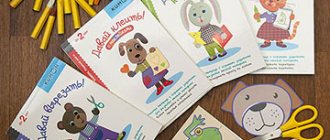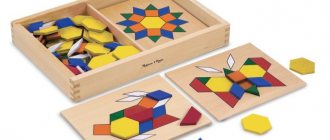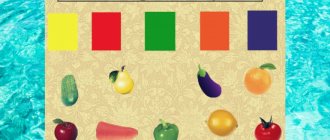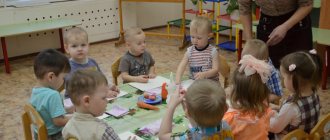This course is aimed at the comprehensive development of a child aged 1 to 2 years.
We place our main emphasis on the intellectual direction - teaching reading and mathematics, developing speech, studying the world around us, developing attention, memory, logic, and thinking. However, the course also contains other elements - creative crafts, listening to classical music, dynamic pauses aimed at developing the child’s gross motor skills.
- Course duration – 10 months (80 lessons)
- Frequency – 2 times a week
- Lesson duration – 50 minutes
- Children study with mothers
- The set includes 80 notes with illustrations and music files.
Features of our notes
№1. Many children's centers operate according to a plan that is largely focused on paperwork. Fruits are studied on cards, seasons too, clothes on a “printout”.
We work differently. A child can go through fruits and vegetables on the cards as much as he wants, but if in one lesson the child “digs” carrots, beets, onions, potatoes from a tray with real soil, in the next lesson he “undresses” the cabbage and divides the head of garlic into cloves, and in the third During the lesson, you will make a vinaigrette, the topic will be absorbed much better.
No. 2. Each summary has 2 variations - for children 1-1.5 years old and 1.5-2 years old . Early childhood development teachers know the huge difference between one-year-old and one-and-a-half-year-old children. Therefore, the difficulty of the exercises for them is different: when two-year-olds cut boiled vegetables for salad with plastic knives, one-year-olds simply pound boiled potatoes.
No. 3. Our notes are based on beautiful and proven methods . For the “Reading” block we use the work of Nikolai Aleksandrovich Zaitsev, for “Development of fine motor skills of the hand” and “The world around us” we take elements from Maria Montessori’s system, and in musical and rhythmic pauses we use the cute compositions of Ekaterina Zheleznova.
Many other modern authors also provide “food” for composing lessons. However, none of the techniques becomes dominant in the lesson. All material is passed through the experience of our teachers and supplemented by their developments.
№4. Our notes are equipped with illustrations, the lion's share of which were created by the designer specifically for our curriculum.
No. 5. We have thematically integrated classes . If the theme of today's lesson is “autumn,” then all lesson blocks, including mathematics and reading, are permeated with autumn themes. The lesson completely immerses you in the study of a particular area.
Topics of notes:
September
1. Autumn. Rain 2. Autumn. Leaves and cones 3. Autumn. Nuts and mushrooms 4-5. Autumn. Berries 6. Autumn. Generalization 7-8. Fruits
October
9-10. Vegetables 11. Generalization 12. Pets. Cat and dog 13. Pets. 14-15. Forest animals 16. Animals. Generalization
November
17-18. Poultry 19-20. Wild birds 21. Birds. Generalization 22-23. Winter hut of animals 24 Winter
December
25. Winter 26. Winter fun 27. Winter fun 28-29. New Year 30-31. Toys 32. Children's playground
January
33. Children's playground 34-35 Our house 36-37. Hallway 38-39. Bathroom 40. Kitchen
February
41. Kitchen 42-43. Bedroom 44. Living room 45. Our home. Generalization 46. Mom's affairs 47. Dad's affairs 48. My family
March
49. My family is 50-51. I'm a 52-53 person. Daily routine 54-55. Spring 56. Spring
April
57. Spring 58-59. Transport 60-61. Transport 62-63. Inanimate nature. Sand and stones 64. Water
May
65. Water 66. Who lives in the pond? 67-68. Sea 69. Day. Morning-Day 70. Day. Evening-Night 71-72. Insects
June
73-74. Summer 75. Repetition and generalization. Tanya and the ball 76. Three little pigs 77. Turnip 78. Chicken Ryaba 79. Teremok 80. Seven little goats
What do you get when you purchase a set of notes?
- You receive 80 notes for classes with children from 1 to 2 years old for 10 school months, 2 times a week,
- Each summary has 2 variations - for children from one to one and a half years and from one and a half to two years.
- You receive illustrations for all notes:
- Colorful pictures for the block “The world around us” for printing or displaying on the screen through a projector
- Black and white worksheets for the unit "Preparing the hand to write" (children take home)
- Creative block illustrations when needed
- You receive files with musical or sound accompaniment (for example, the sound of water, the roar of an animal, the chimes, a folk song), when this does not violate anyone's copyright. In other cases - in particular, for songs by Ekaterina Zheleznova - we give an indication of the disk that contains the required melody.
And bonuses:
Bonus No. 1
A list of everything you will need for classes - toys, teaching aids, stationery and much more.
Bonus No. 2
Scenarios for three holidays for children of this age. The scripts have been worked out and contain recommendations for the design of premises, descriptions of props, costumes and scenery, and musical accompaniment.
Reviews
According to our notes, hundreds of children's centers in Russia and the CIS countries are already operating. They received the approval of not only practical teachers, leaders of children's clubs, but also very respected representatives of the scientific community.
Podvoisky V.P., professor, Doctor of Pedagogical Sciences, Candidate of Psychological Sciences, member of the educational and methodological council for early childhood development, professor of the Department of Psychology at Moscow Pedagogical State University:
“The considered methodology of Yu. Belotserkovskaya and Z. Ivanter represents interesting material, which is sufficiently updated in the light of reforming the modern system of preschool education...”
“The components of the classes (greeting, warming up, reading, logorhythmics, mathematics, studying the properties of objects, general motor, finger gymnastics, artistic and creative activities / applique, drawing, modeling /, farewell) not only correspond to the natural course of dramaturgy, but also allow you to engage emotionally -sensory, visual-motor, tactile-auditory perception of children..."
“In such psychological and pedagogical conditions, the time frame of attention expands, and memory begins to intensify its work...”
“The applications used in the methodology are not just a colorful addition, but are organically woven into the content of the plot and semantic lines. They allow you to make the necessary accents, switch attention and continue to “swim children on the wave of new knowledge”...
“The analyzed methodology should be published in a good edition so that it becomes fully accessible to Early Childhood Development Centers.”
Blokh O.A., Doctor of Pedagogical Sciences, Professor of the Department of Pedagogy and Psychology, member of the Union of Writers of the Russian Federation, General Director of Children's, Vice-President of the International Academy of Informatization at the United Nations (department of music, education):
“The methodology […] arouses interest and deserves attention at the structural, content and technological levels. The methodology includes lesson notes, checklists (list of materials used, props, developmental elements), various musical, visual and artistic applications. The structure of the lesson represents a holistic system construction and accumulates such important components as greeting, warm-up, reading, logarithmics, mathematics, studying the properties of objects, general motor, finger gymnastics, artistic and creative activities (appliqué, drawing, modeling, etc.), farewell ( the final). Each section of classes has its own target setting...”
“It should be noted as a positive aspect the creation of a creative environment in the classroom through the active participation of children, parents and teachers in the developmental process based on the development of a culture of communication and a culture of behavior. In this method, the processes of training and education are naturally intertwined and form a harmonious whole...”
“It is important to pay attention to the fact that all the material in the methodology fully complies with the principles of health-preserving pedagogy and meets the multifaceted specifics of the early holistic development of children...”
“The methodology can be published in a scientific and methodological publication and serve as the basis not only for practical activities, but also for scientific and creative research...”
View original reviews in full for all courses
An integrated approach to teaching children
How to organize classes with an impulsive, active child who cannot yet concentrate on one type of activity for a long time?
It should be noted that this behavior is largely a feature of this age. The baby’s skeleton and muscles are just developing, and at this stage of development the body is not yet able to remain in the same static position for a long time. Therefore, quiet activities that require attention and concentration should be combined with active games.
The peculiarities of the mental activity of a young child are such that he cannot concentrate on one type of activity for a long time and quickly gets tired.
The baby’s attention is also short-lived, and sometimes “field behavior” takes place: the child moves in space, striving for an object that has attracted his attention, but as soon as the child reaches it, another object comes into his field of vision - and the baby rushes towards it, forgetting about it. first. It is clear that such chaotic behavior does not bear fruit, because the child does not truly examine objects.
Therefore, during the lesson, an adult must regulate the child’s behavior: the adult makes special efforts to interest the child in some kind of game, and during the game he watches the baby - at the first sign of fatigue or loss of interest, you need to end this game and start a completely different one.
In addition, it must be taken into account that a small child can fully study only if he is well-fed, satisfied and not busy with any activity that is important to him, and it is better not to take him away from it for the sake of studying. Nevertheless, it is quite possible to smoothly transform the baby’s activity into a real educational game (of course, independent activity also develops the baby, but a specially organized educational activity has a different quality and usually develops and teaches at a higher level).
Thus, if desired, we can fit from 2-3 to 4-8 diverse mini-games into one full-fledged lesson with a child. For example,
- While the child is full of energy, we start with the most difficult thing - speech development (for example, we read 2-3 pages from a special book and look at the pictures or finish the words in a familiar nursery rhyme);
- then we invite the child to “feed the mouse” - put the beans into a jar with a hole in the lid, thus developing the baby’s fine motor skills;
- After that, we get up from the table and play the outdoor game “Repeat after me!” (imitation of the movements of an adult);
- then we return to the table and draw straight lines with felt-tip pens - “strings for balls”;
- after drawing, we sit down on the carpet and “build houses”, selecting cubes and prisms of the same color and thus studying the colors;
- You can end the lesson with something very pleasant for the child - for example, an emotional game of hide and seek, in which a large scarf is used (in this case, the baby will have a particularly pleasant memory of the lesson, he will look forward to the next one).
This is what a comprehensive activity with a baby is like. Each game lasts several minutes, and the number of games can be flexibly changed depending on the child’s condition.
If the mother is working with the child at home, you can play these games throughout the day, taking breaks between them.
Cost of a set of notes
| 1 month | 8 fully written notes, each of which has two variations: for ages one and a half and one and a half to two years + Illustrations for notes + Sound files (the sound of rain, animal voices, chimes, folk songs, etc.) | 6400 rub. |
| 5 months | 40 fully written notes, each of which has two variations: for ages: one and a half and one and a half to two years + Illustrations for notes + Sound files (the sound of rain, animal voices, chimes, folk songs, etc.) | 29900 rub. |
| 10 months | 80 notes + Illustrations for notes + Sound files (the sound of rain, animal voices, chimes, folk songs, etc.) + Bonus No. 1. List of all toys, teaching aids and stationery that will be required for classes + Bonus No. 2. Scenarios for three holidays | 44900 rub. |
If you have ever been interested in the question of building an educational process in a children's center, you immediately realized how attractive this offer is. When purchasing a complete set of notes, one month costs 4,500 rubles. In Moscow, this is the cost of one monthly subscription. That is, one new client will already recoup your investment in notes. (Outside Moscow, this is the cost of three or four subscriptions. This means that your investment will return three or four new clients).
At the same time, the presence of this curriculum in the club will attract not just a few, but dozens of new students.
Developmental track.
We train coordination of movements, leg and back muscles.
Together with your child, build a long and winding path from books:
Some fragments of the path can be made massage - place a massage mat, or boxes/large bowls with massage material (cereals, beans):
Scatter some objects on the path (for example, pine cones, nuts, cotton pads, etc.). Ask your child to walk down the path with a baby bucket and collect all the scattered items into the bucket.
How quickly will you receive your notes?
Very fast. Previously, we sent material on disk, but due to disruptions in the work of postal operators, we abandoned this practice and introduced the transfer of information through a personal account.
How does this happen? We will send you a login and password so that you can log into your personal account and save all materials on your computer. The information is not stored on a disk, which can be scratched, broken or lost, but on your computer. You will receive your order quickly and in an easy-to-use form.
So if you want:
- Have a consistently high quality of classes, ensured by documented processes
- Save on teachers' salaries by attracting young specialists
- Do not depend on the whims of star teachers
- Minimize the risk of losing clients due to teachers leaving
- Conduct classes according to a program that has already been worked out by other successful children's centers and highly qualified teachers
- Work in the most productive mode, without being distracted by buying study guides and drawing handouts
- Attract more clients by explaining to parents that the club has its own methods of child development, telling in detail about the classes provided
- Spend holidays with children according to detailed and worked out scenarios, including descriptions of props,
then this kit may come in handy.
Precautions for organizing gaming activities
We must not forget about safety rules. All items used for games should not have sharp corners, small parts, or toxic substances in their composition. It is better if these are specialized toys for children.
Drawing develops imagination and motor skills
Also, the place for games must meet the basic requirements:
- distance from wires and power supply;
- absence of glass doors, corner countertops, piercing and cutting objects;
- flat surface for movement.
If the mother can answer affirmatively to a number of questions, then the organization of play activities was as safe as possible. Does the item pose a threat to the child? Can I safely leave my baby alone with this item? Is it possible to leave the room for a short period of time without fear for the child’s health?
Tests for children 2-3 years old
What the future of children will be depends largely on their parents.
And you should start building a path to a bright life for your child here and now.
Being a mother is not just about finding a woman’s happiness, it is also about long and tedious work, a huge supply of patience and a sea of invested energy. But at the moment when the time comes to reap the fruits of their efforts, rejoicing in the significant successes of their child, not a single mother will remember the time spent and sleepless nights. leave a comment








